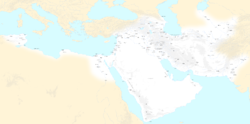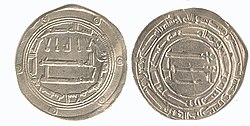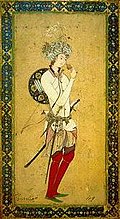Harun al-Rashid

Harun al-Rashid (also: Haroon al-Rasheed), was an Arab caliph of the Abbasid Empire, ruling from 786 to 809. He has become an icon of the Islamic golden age. He appears in many stories as a wise ruler, who often disguised himself as a peasant in order to walk amongst the people in Baghdad to find out how they lived and how he could improve their situation. His legacy has been cemented through his representation in the Arabian Nights.
Domestically, Al-Rashid pursued policies similar to those of his father al-Mahdi. He released many of the Umayyads and 'Alids his brother al-Hadi had imprisoned and declared amnesty for all political groups of the Quraysh.[1] Large scale hostilities broke out with Byzantium, and under his rule, the Abbasid Empire reached its peak.[2]
Harun Al-Rashid Media
Map of the Abbasid Caliphate and its provinces, c. 788
A silver dirham minted in Madinat al-Salam (Baghdad) in 170 AH (786 CE). At the reverse, the inner marginal inscription says: "By order of the slave of God, Harun, Commander of the Faithful"
Harun al-Rashid at left receiving a delegation sent by Charlemagne to his court in Baghdad.1864 painting by Julius Köckert.
Harun al-Rashid as depicted in the Arabian Nights (One Thousand and One Nights).
Sketch drawing of Harun al-Rashid by poet and visual artist Kahlil Gibran (1883–1931)
A sketch representation of Hārūn al-Rashid from a book entitled Sayr Mulhimah: Min al-Sharq wa-al-Gharb, first translated into Arabic and published in Egypt, 1381 AH/1961
References
| Wikimedia Commons has media related to Lua error in Module:Commons_link at line 62: attempt to index field 'wikibase' (a nil value).. |
- ↑ Ghareeb, Edmund A.; Dougherty, Beth (18 March 2004). Historical Dictionary of Iraq. ISBN 9780810865686.
- ↑ Ghareeb, Edmund A.; Dougherty, Beth (18 March 2004). Historical Dictionary of Iraq. ISBN 9780810865686.









